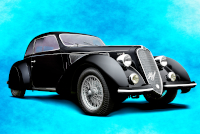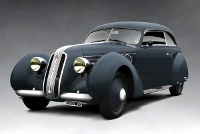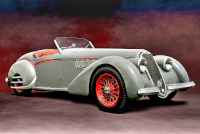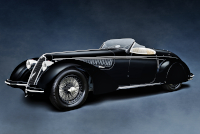Location:
Elegance at Hershey, 2015
Owner: Oscar Davis (late) | Elizabeth, New Jersey
Prologue:
The world was not kind to Michel Dovaz, though I suspect we've lately grabbed hold of a better understanding of what he was about. This car, the herald of Touring's Superleggera coachwork process, survived because of him, not in spite of him.
Where the focus on classic Alfa trends toward the 8C as we near the end of the decade, the origin of its Milanese clothing rests in the lesser sibling. These are the cars of Zumbrunn's "Italian Auto Legends," those that differ in their execution across the 6C range as Carlo Felice Bianchi Anderloni works out the form. So the 6C 2300B is not one to overlook.
Discovering a connection to a good story of social value makes the graphic work worthwhile. And discovering a previous restoration that applies to the car in question piques my interest even more, opening the opportunity to illustrate a lost rendition. Luckily, I photographed the main quarter shot twice. The blue Netherlands version depicted here, based on the car's 1990s restoration, comes from a lone shot taken in the afternoon. The posture is slightly longer (sidelong), the car slightly closer, and the framing tighter. (And of course the driver side window is open.)
But I do opine for these enthusiastically colorful renditions; they represent a time when cars like this 6C seemed old and nifty, and that was good enough. No need to discuss the roots of elegance or the shortcomings thereof compared to the ultimate versions yet to come. A bright blue berlinetta was good fun, "classic" in a sense we've now lost.
- - - - - - - - - -
► Image Source: Nikon D750 (24.3 MP)
References:
- Czap, Nick. "Museo Storico Alfa Romeo: The Catalogue" Giorgio Nada Editore, Milano, Italia. 2015, page 115
- d'Amico, Stefano. "Pure Alfa Romeo" Libri Illustrati Rizzoli, Milano, Italia. 2017, page 72-75
- Just a Car Guy: This blog offers a few pictures from the first Hesselmann publication. In the single plate of four pictures, the lower right frame shows the tail of #815053 next to a Bugatti and a Cord L-29.
- Topgear Autoguide: Excerpts from the second publication, where Dovaz discusses the cars with Ard and Arnoud op de Weegh.
- Bugatti Builder: Herman Brouwer attended the release of "The Fate of the Sleeping Beauties" at the Louwman Collection in the Hague, Netherlands. He describes the event, attended by Michel Dovaz, whom he met.
- Gooding & Company: Short information page showing the highlights and result from the car's 2008 auction.
- UltimateCarPage: Basic information on the Alfa Romeo 6C 2300B Mille Miglia, by Wouter Melissen, August 15, 2005.
While part of an endeavor committed to Alfa Romeo, this 6C 2300B connects us with the well known Sleeping Beauties story. Often referenced in the car's history, chassis #815053 sat among the collection of Michel Dovaz, a Swiss-born wine expert and food writer. His cars lived on an estate called Villemaréchal a ways south of Paris. The cars remained unknown from the time Dovaz moved to Villemaréchal in 1964 until 1983, when Herbert Hesselmann published a pictorial titled, "Sleeping Beauties." Global attention, most of it unwanted and some portion downright militant, dogged Mr. Dovaz in the wake of the publication, eventually forcing him to relocate the collection.
With so much said about the history of chassis #815053, we tend to overshadow the intrinsic value of the 6C 2300B Mille Miglia car itself. (Michel Dovaz would disapprove.) While the concours crowd lauds the 8C Alfa, indeed the pinnacle of classic era sports cars, it is the 6C 2300B that cemented Alfa Romeo's sporting reputation and the value of Touring's Superleggera patent. Uprated versions of the short chassis 6C 2300 replaced the Pescara at the upper limit of the firm's popular 6-cylinder range.
Adding 10 horsepower to the Pescara and reducing weight through Touring's Superleggera fabrication, using aluminum panels on steel lattice, the new car continued to win on the Targa Abruzzo for which the Pescara had been named, where the reliable 6-cylinder proved adept even against the more powerful 8C. Alfa Romeo then sent the new car to the 1937 Mille Miglia. Ercole Boratto, who was Benito Mussolini's personal driver, and Alfa test driver Giovanni Battista Guidotti placed fourth overall, easily winning their class—a feat considering the power of the top-end competition.
From 1938 to 1939, Alfa Romeo sold the 6C 2300B Mille Miglia direct to the consumer with Touring Superleggera coachwork, hanging the names of both the marque and the coachbuilder on racing success. More than 100 examples carried the message across the roads of Europe, far more prolific than the ultra-exclusive 8C 2900 masterwork that followed.
Sleeping Beauties: Sympathy for Michel Dovaz and the Alfa Romeo 6C 2300 Touring Berlinetta
Somewhat independently, Ard op de Weegh, Arnoud op de Weegh, and Kay Hottendorff, who had ealier traced the cars to Mr. Dovaz over the course of a few years, published a follow-up book in which Mr. Dovaz explained his affinity for the automobiles and his role as their steward. All remained within reach of restoration. Some partook in their owner's own plans, as in an Alfa Romeo 6C 2500 competizione Dovaz restored and ran on the 1984 Mille Miglia retrospective. Some found new owners, while some stayed with the collection. This second publication—titled, "The Fate of the Sleeping Beauties"—tempered the sensationalism created by the initial pictorial.
Dovaz is interesting in that he sat rather uncomfortably in the front row of the 20th century collector car craze. For the time he remained invisible, he witnessed the automobile's transition from an artefact worth its weight in scrap metal to a new-age luxury item. Under scrutiny, he rightfully defended his position as a steward and not a collector, saying to Ard and Arnoud op de Weegh, "I wonder where all the so-called enthusiasts were when Bugatti and other valuable cars were still being scrapped. The heavier the more valuable, at least for the scrap dealer... many only became interested in old cars when they were found to be valuable. Then the car became a collector's item, and now the so-called enthusiasts outbid each other to acquire the most beautiful car. The honor goes to the owner and not to the vehicle."
In this respect, Dovaz appears more pragmatic than eccentric, even though the latter term reads better in the press. From many years and a great distance away, I can only agree that his resolve preserved more than 50 grand marque automobiles, and I would not have wished ill over some rust and bent body panels.
As for chassis #815053, Hesselmann's photographs show the tail of the car sharing a stone barn reportedly near the center of Villemaréchal, one of six cars under cover, two of them Cords and the other three Bugatti. I have read second-hand that the originally published book referred to the Alfa as a Fiat. The Alfa had been first imported to Switzerland in 1946. Subsequent to Dovaz' ownership, the Alfa passed through a series of European owners whence it occasionally appeared publicly in its unrestored state. Douwe Heida of the Netherlands purchased and restored #815053 in the 1990s. The last illustration in this set recreates the car as originally restored, with its blue paint as supposedly verified by Carrozzeria Touring. The Alfa Romeo's present form, black, follows its American incarnation, which reflects a conservative concours restoration.
Motor: 2,309 cc straight 6-cylinder, cast-iron block, aluminum head | 70 mm x 100 mm | 7.8:1 compression
Valvetrain: DOHC, 2 valves per cylinder
Aspiration: triple Solex 35-40 FH carburettors
Power: 95 bhp at 4,500 rpm
Drivetrain: Originally a 4-speed gearbox
Chassis #815053 currently sends power to the rear wheels through an Alfa Romeo Giulietta Sprint Veloce 5-speed gearbox and BMW clutch assembly.
Front Suspension: trailing arms, coil springs over dampers
Rear Suspension: swing axle, friction dampers
Architecture: box-type chassis with aluminum coachwork by Touring of Milan
Kerb Weight: 1,380 kg (3,042 lbs)
Wheelbase: 3,000 mm (118.1 inches)
Top Speed: 145 km/h (90 mph)
Etymology:
'6C 2300' refers to the motor configuration, a straight 6-cylinder of about 2.3 litres displacement. The 'B' designation indicates that this is the second series of the 6C 2300. 'MM' denotes the short-chassis, lightweight variant, named in honor of Alfa's success on the Mille Miglia. Touring of Milan crafted the aluminum coachwork.
Figures:
Of approximately 1,606 6C 2300 cars, 211 are short-chassis, whereas 106 are Mille Miglia examples. Of the Mille Miglia cars, only seven are Touring-bodied. These cars succeeded the 60-some versions built to Pescara specification, as in the unique 1937 Pinin Farina Speciale, #813812. The Touring Superleggera coachwork seen on this example remains renowned, as it is one of the earliest examples of the practice, which Touring had patented in 1936, proving its value in competition and in the commercial prestige of the cars that wore the moniker. Touring's Carlo Felice Bianchi Anderloni developed the aluminum-on-steel-lattice method from a Weymann license. Charles Weymann had earlier developed fabric-on-frame coachwork based on his aviation experience.
Value:
In 2023, chassis #815053 sold at RM Sotheby's Paris auction for €850,000 (approximately $928,400).
Chassis #815053 sold at a Gooding & Company auction in 2008 for $2,585,000.
8C Nose: Similarity between the Touring 6C and 8C Fascia
From the front, the Mille Miglia version of the 6C 2300B looks very similar to the 8C 2900B. Touring's coachwork carries nicely between the two. We've similar shots of both a black 6C and a navy 8C (#412027), and at a glance one could easily think the former to be the latter.
Understated Design: Clever Berline Shape for the 6C 2300
The 6C 2300B expresses a primitive antiqueness that Touring and Alfa Romeo finessed with the more intentional 8C 2900B. The proportions satisfy the utility of a small berline, rather than the tight closed-coupe design associated with a sporting marque. And though a short chassis version, the Mille Miglia appears long thanks to its long cabin line and slant-back tail. In sum, the car appears dashing from the front, but transitions along the length to a more practical layout, space enough for the back seat.
Netherlands Version: Illustrating the Sleeping Beauty Touring Berlinetta as First Restored
A couple differences seem perplexing between the Alfa as restored in the Netherlands during the 1990s (blue with a red interior) and as restored prior to 2008 (black with a green interior). Note that the car ran more prominent running boards and used a larger trafficator mounted higher on the bulkhead, which is consistent with many other 6C 2300B MM cars. Both features appear to have been inherited from the car as preserved at Villemaréchal.
The most obvious difference is the rear wheel skirting, which earlier vented the wheel through a three-slot pattern. When the car appeared for auction in 2008, the color changed and the skirts returned solid, not slatted. From my armchair, I cannot untwist which features owe their expression to originality apart from preference. I like the Netherlands version a little better because I appreciate color and stylization, but I don't dislike the car's present black exterior and simplified lines. Plus the deep green interior is incredibly handsome. Best have both. One final note is that the Netherlands car included two wing mirrors, top and bottom of the door frame, on the driver side. I did not draw these items on my re-creation simply not to interrupt the lines.
Last Updated: Mar 26, 2025









